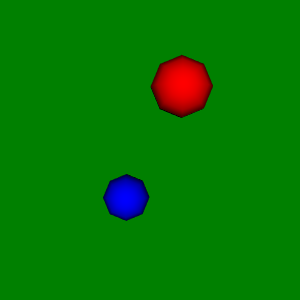TransformPolyData
vtk-examples/Cxx/Filtering/TransformPolyData
Description¶
This example demonstrates how to apply a transform to a data set. It uses vtkTransformPolyDataFilter, but it can be replaced with vtkTransformFilter for different types of data sets, including vtkUnstructuredGrid and vtkStructuredGrid. vtkTransformFilter will work with vtkPolyData, too).
Question
If you have a question about this example, please use the VTK Discourse Forum
Code¶
TransformPolyData.cxx
#include <vtkActor.h>
#include <vtkNamedColors.h>
#include <vtkNew.h>
#include <vtkPolyDataMapper.h>
#include <vtkProperty.h>
#include <vtkRenderWindow.h>
#include <vtkRenderWindowInteractor.h>
#include <vtkRenderer.h>
#include <vtkSphereSource.h>
#include <vtkTransform.h>
#include <vtkTransformPolyDataFilter.h>
int main(int, char*[])
{
vtkNew<vtkNamedColors> colors;
// Create the polydata geometry
vtkNew<vtkSphereSource> sphereSource;
sphereSource->Update();
// Set up the actor to display the untransformed polydata
vtkNew<vtkPolyDataMapper> originalMapper;
originalMapper->SetInputConnection(sphereSource->GetOutputPort());
vtkNew<vtkActor> originalActor;
originalActor->SetMapper(originalMapper);
originalActor->GetProperty()->SetColor(colors->GetColor3d("Blue").GetData());
// Set up the transform filter
vtkNew<vtkTransform> translation;
translation->Translate(1.0, 2.0, 3.0);
vtkNew<vtkTransformPolyDataFilter> transformFilter;
transformFilter->SetInputConnection(sphereSource->GetOutputPort());
transformFilter->SetTransform(translation);
transformFilter->Update();
// Set up the actor to display the transformed polydata
vtkNew<vtkPolyDataMapper> transformedMapper;
transformedMapper->SetInputConnection(transformFilter->GetOutputPort());
vtkNew<vtkActor> transformedActor;
transformedActor->SetMapper(transformedMapper);
transformedActor->GetProperty()->SetColor(
colors->GetColor3d("Red").GetData());
// Set up the rest of the visualization pipeline
vtkNew<vtkRenderer> renderer;
renderer->AddActor(originalActor);
renderer->AddActor(transformedActor);
renderer->SetBackground(colors->GetColor3d("Green").GetData());
vtkNew<vtkRenderWindow> renderWindow;
renderWindow->AddRenderer(renderer);
vtkNew<vtkRenderWindowInteractor> renderWindowInteractor;
renderWindowInteractor->SetRenderWindow(renderWindow);
renderWindow->SetWindowName("TransformPolyData");
renderWindow->Render();
renderWindowInteractor->Start();
return EXIT_SUCCESS;
}
CMakeLists.txt¶
cmake_minimum_required(VERSION 3.12 FATAL_ERROR)
project(TransformPolyData)
find_package(VTK COMPONENTS
CommonColor
CommonCore
CommonTransforms
FiltersGeneral
FiltersSources
InteractionStyle
RenderingContextOpenGL2
RenderingCore
RenderingFreeType
RenderingGL2PSOpenGL2
RenderingOpenGL2
)
if (NOT VTK_FOUND)
message(FATAL_ERROR "TransformPolyData: Unable to find the VTK build folder.")
endif()
# Prevent a "command line is too long" failure in Windows.
set(CMAKE_NINJA_FORCE_RESPONSE_FILE "ON" CACHE BOOL "Force Ninja to use response files.")
add_executable(TransformPolyData MACOSX_BUNDLE TransformPolyData.cxx )
target_link_libraries(TransformPolyData PRIVATE ${VTK_LIBRARIES}
)
# vtk_module_autoinit is needed
vtk_module_autoinit(
TARGETS TransformPolyData
MODULES ${VTK_LIBRARIES}
)
Download and Build TransformPolyData¶
Click here to download TransformPolyData and its CMakeLists.txt file. Once the tarball TransformPolyData.tar has been downloaded and extracted,
cd TransformPolyData/build
If VTK is installed:
cmake ..
If VTK is not installed but compiled on your system, you will need to specify the path to your VTK build:
cmake -DVTK_DIR:PATH=/home/me/vtk_build ..
Build the project:
make
and run it:
./TransformPolyData
WINDOWS USERS
Be sure to add the VTK bin directory to your path. This will resolve the VTK dll's at run time.
